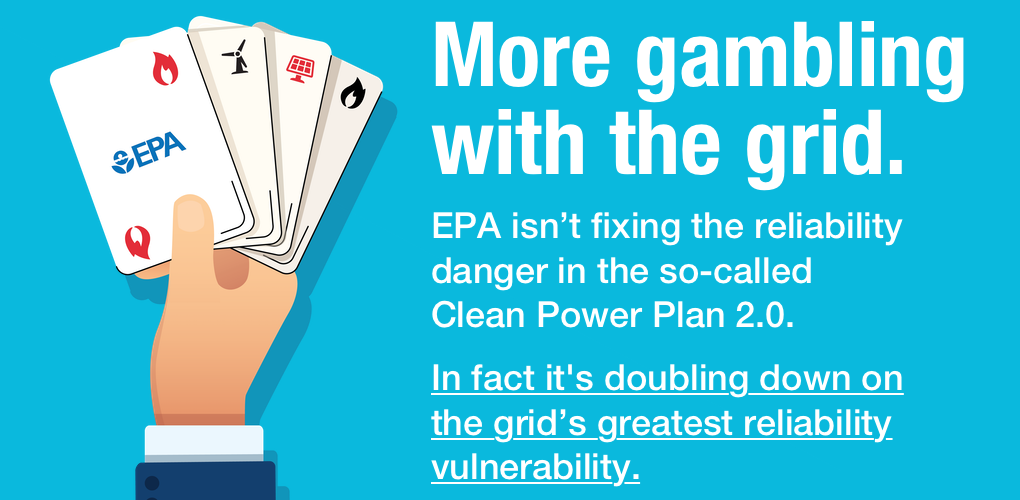
EPA Misses the Point on Grid Reliability
The U.S. Environmental Protection Agency (EPA) has picked a winner in the energy markets and, in doing so, the American people will undoubtedly be the losers.
Yesterday, the news broke that existing natural gas power plants will be exempted from the so-called Clean Power Plan 2.0. While EPA claims that a new comprehensive rule on existing gas plants will come later, just when – or if ever – such a rule is proposed is anyone’s guess.
The EPA claims its decision is about grid reliability. But, in reality, by keeping unworkable technology mandates in place for the existing coal fleet, EPA isn’t fixing the reliability danger in the rule; it’s in fact doubling down on the grid’s greatest reliability vulnerability.
The Grid’s Gas Problem
While the flexibility of the natural gas fleet is critically important to balancing the variability of renewable generation, a deeply valuable capability under most operating conditions, the gas system – from wellhead to power plant – has proven to be extraordinarily susceptible and unreliable during bitter cold.
It has been the poor performance of the gas system that has pushed the grid to the verge of disaster – or actual disaster – again and again over the past few years.
Notably, it was the failure of the gas delivery system in Texas that precipitated the near collapse of the state’s grid during winter storm Uri in February of 2021 that left millions in the dark and claimed the lives of 246 people.
During winter storm Elliot in December of 2022, the gas system was once again the leading culprit in a grid crisis that saw rolling blackouts in multiple Eastern states and nearly cost more than a million families in New York City their heating.
A stunning 90.5 GW, or 13% of the generating capacity in the Eastern Interconnection — the grid system covering two-thirds of the U.S. — failed to run or operated at reduced capacity during Elliot.
Gas-fired capacity accounted for 63% of the outages. On the PJM grid, the nation’s largest regional grid serving 65 million Americans, gas capacity accounted for 70% — or 32 gigawatts – of outages, enough capacity to power more than 20 million homes.
In January of 2018, during another polar vortex event, half of the total PJM natural gas capacity was not available to supply peak demand. And in February of 2014, during another cold snap, PJM found that 23% of total generator outages were due to interruptions of natural gas supply. In both 2018 and 2014, it was coal generation that came to the rescue, ramping up power supply when gas couldn’t.
Regulators Demand Action on the Gas Vulnerability
So concerning was the Elliot-induced crisis and the failure of the gas system, a joint after action report from the Federal Energy Regulatory Commission (FERC) and the North American Electric Reliability Corporation (NERC), prompted FERC Chairman Willie Phillips to call upon Congress to fix the gas system’s regulatory “gap.”
“We need someone who is directly responsible for the reliability of our natural gas systems and for enforcing reliability standards for the natural gas system,” said Phillips.
As E&E News described, “essentially, there are no mandatory federal reliability standards for the entire natural gas system, from wellheads to pipelines to gas distribution lines. That’s different from the electric grid and power plants, which are largely subject to such standards, even though both systems are increasingly interdependent.”
Elliott was the fifth event in the past 11 years during which a large number of U.S. power plants failed during severe cold. The gas system was at the center of each failure.
“Five events in 11 years, three events in the last five — that’s too often. These are not infrequent events,” Jim Robb, CEO of NERC, said.
The gas regulatory gap, and the vulnerability it has embedded in the U.S. energy system, has yet to be addressed.
EPA is now in effect putting ever more eggs in the natural gas basket when it’s the one place where federal regulators have the least authority to guarantee performance.
Targeting the Coal Reliability Backstop
While no power source has been immune to the bitter cold that has forced power plant outages, the coal fleet – aided by the fuel security of having months of fuel on site – has proven to be a reliability backstop during these peak winter generation events.
If EPA was serious about addressing the grave risks to grid reliability posed by its proposed rule, it would prioritize flexibility for the coal fleet. Instead, EPA remains committed to impossible and unlawful technology mandates that will only accelerate the closure of essential plants.
Regardless of how EPA tries to spin its decision, the gravest threat to the reliability of the U.S. electricity grid remains unaddressed.
Until EPA recognizes the critical importance of the fuel security and dispatchable fuel diversity provided by the coal fleet, and scraps its regulatory blitz, the nation remains on collision course with a grid catastrophe of the EPA’s making.
- On March 1, 2024
